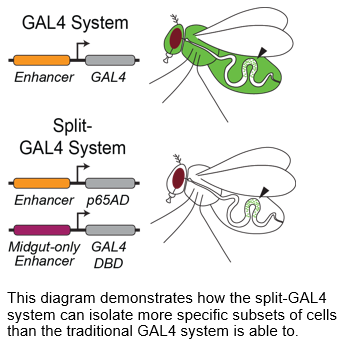The BDSC has collaborated with Nick Sokol’s lab to examine the expression of split-GAL4 drivers in the intestine. The original study was conducted in two separate screens in 2020 with an additional follow-up screening for enteroendocrine cells in 2021. We present the data and images from these screens in the following pages:
Primary screen for midgut expression - We combined ~7,300 split-GAL4 drivers with reference drivers that limit UAS-GFP expression to the midgut and identified 424 drivers expressed in at least one of five major midgut regions.
Secondary screen for expression in specific intestinal cell types - We combined the 424 split-GAL4 drivers expressed in the midgut with drivers that limit UAS-GFP expression to progenitor cells, enteroblasts, enterocytes or enteroendocrine cells, and documented cell type-specific expression in eleven, more finely delineated midgut regions.
Enteroendocrine cell screens - We combined 88 candidate split-GAL4 drivers with two different drivers that limit UAS-GFP expression to enteroendocrine cells to identify combinations with expression in enteroendocrine cells that may have been missed by the primary and secondary screens described above.
We combined 13 additional split-GAL4 drivers associated with common panneuronal genes with the same enteroendocrine cell reference drivers to determine the extent to which these drivers directed expression in enteroendocrine cells.

This primary and secondary screens are described in Ariyapala et al. (2020) "Identification of split-GAL4 drivers and enhancers that allow regional cell type manipulations of the Drosophila melanogaster intestine".
The enteroendocrine cell screen is described in Holsopple et al. (2022) "Identification of novel split-GAL4 drivers for the characterization of enteroendocrine cells in the Drosophila melanogaster midgut."
The enteroendocrine cell screen of panneuronal-associated enhancer fragments is described in Holsopple et al. (2022) "Enteroendocrine cell expression of split-GAL4 drivers bearing regulatory sequences associated with panneuronally expressed genes in Drosophila melanogaster."
This work was supported by NIH grants R21 OD026525 and P40 OD018537.

